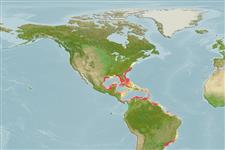Actinopterygii (Straalvinnigen) >
Perciformes (Perch-likes) >
Serranidae (Sea basses: groupers and fairy basslets) > Epinephelinae
Etymology: Mycteroperca: Greek, mykter, -eros = nose + Greek, perke = perch (Ref. 45335).
Omgeving / Klimaat / Range
Ecologie
; marien; brakwater rifbewoner; oceanodroom (Ref. 51243); diepteverspreiding 30 - 160 m (Ref. 89707). Subtropical, preferred 24°C (Ref. 107945); 40°N - 27°S, 98°W - 38°W (Ref. 5222)
Western Atlantic: North Carolina, USA (with juveniles occurring as far north as Massachusetts) to the Yucatan Peninsula, Mexico. Rare in Bermuda; one record in Cuba; also reported from eastern Brazil.
Length at first maturity / Size / Gewicht / Leeftijd
Maturity: Lm ?, range 58 - ? cm
Max length : 145 cm TL mannelijk/geslacht niet bekend; (Ref. 40637); common length : 50.0 cm TL mannelijk/geslacht niet bekend; (Ref. 3708); Maximaal gepubliceerd gewicht: 36.5 kg (Ref. 40637)
Dorsale stekels (totaal): 11; Dorsale zachte stralen (totaal): 16-18; Anale stekels 3; Anale zachte stralen: 10 - 12. Distinguished by the following characteristics: adult females and juveniles are generally brownish grey with dark vermiculations; camouflage phase has 5 dark brown saddles separated by short white bars below the dorsal fin; large males sometimes display a "black-belly" and "black-back" phase; black-belly phase is mostly pale grey, with faint dark reticulations below soft dorsal fin, belly and ventral part of the body above anal fin black, as are margin of the soft dorsal fin, central rear part of caudal fin and rear margins of pectoral and pelvic fins; depth of body contained 3.0-3.5 times in SL; head length 2.5-2.7 times in SL; convex interorbital area; angle of preopercle produced into a rounded lobe bearing enlarged serrae; posterior nostrils of adults much larger than anterior ones; smooth lateral body scales, except those covering pectoral fin (Ref. 89707).
Juveniles occur in estuaries and seagrass beds; adults are usually found offshore on rocky bottom (rarely to 152 m), occasionally inshore on rocky or grassy bottom. It is the most common grouper on rocky ledges in the eastern Gulf of Mexico. Adults are either solitary or in groups of 5 to 50 individuals; feed mainly on fishes, some crabs, shrimps, and cephalopods. Juveniles (less than 20 cm) feed mainly on crustaceans that live in shallow grass beds.
Indeterminate, multiple spawner (Ref. 86690).
Heemstra, P.C. and J.E. Randall, 1993. FAO Species Catalogue. Vol. 16. Groupers of the world (family Serranidae, subfamily Epinephelinae). An annotated and illustrated catalogue of the grouper, rockcod, hind, coral grouper and lyretail species known to date. Rome: FAO. FAO Fish. Synop. 125(16):382 p. (Ref. 5222)
Status op de Rode Lijst van het IUCN (Ref. 115185)
CITES (Ref. 94142)
Not Evaluated
Gevaarlijk voor mensen
Harmless
Gebruik door de mens
Visserij: van groot commercieel belang; vis voor de hengelsport: ja
Tools
Speciale rapporten
Download XML
Internet-bronnen
Estimates of some properties based on models
Phylogenetic diversity index (Ref.
82805): PD
50 = 0.5000 [Uniqueness, from 0.5 = low to 2.0 = high].
Bayesian length-weight: a=0.01122 (0.00659 - 0.01911), b=3.04 (2.90 - 3.18), in cm Total Length, based on LWR estimates for this species & Genus-body shape (Ref.
93245).
Trophic Level (Ref.
69278): 3.7 ±0.4 se; Based on diet studies.
Weerstandsvermogen (Ref.
69278): Gemiddeld, minimale populatieverdubbelingstijd 1,4-4,4 jaar (K=0.12-0.16; tm=3-8; tmax=16; Fec>10,000).
Prior r = 0.44, 2 SD range = 0.24 - 0.81, log(r) = -0.82, SD log(r) = 0.3, Based on: 4 M, 6 K, 4 tgen, 1 tmax, 4 Fec records
Kwetsbaarheid (Ref.
59153): High to very high vulnerability (68 of 100) .
